Father Christopher Epps reflects on five years of the Holy Commotion fresh expression of church in Cornwall and the evolution of Together in Worship.
These days it is not unusual for our numbers to be in excess of 90, adults and children, on a Wednesday evening when we meet for Holy Commotion at Archbishop Benson CEVA School in Truro.
 Our journey has been one of great joy and constant surprises; all is not perfect but the joys far outweigh the few negatives. With a fresh expression of church I have been struck time and again – not just with the increasing numbers but by the fact that no-one attends because they feel they have to be there. Everybody attends because they want to be there. I certainly don't sense that we have got to the stage where parents are saying, 'Oh it's Wednesday, we'd better go to church.' Often it is the children who urge parents to keep on coming along simply because they enjoy it so much.
Our journey has been one of great joy and constant surprises; all is not perfect but the joys far outweigh the few negatives. With a fresh expression of church I have been struck time and again – not just with the increasing numbers but by the fact that no-one attends because they feel they have to be there. Everybody attends because they want to be there. I certainly don't sense that we have got to the stage where parents are saying, 'Oh it's Wednesday, we'd better go to church.' Often it is the children who urge parents to keep on coming along simply because they enjoy it so much.
As a parish priest it is utterly refreshing to minister to people who come without church 'baggage' and there is none of the political manoeuvring that can sometimes afflict parish life. Holy Commotion has definitely formed a core of people who now regard the 'church in the school' as their own. We are a distinct Christian community – church in the literal sense. We are not tied to a specific building though there have been occasions when we have visited one of my other local churches to enable parents and children to explore a church building.
At other times, when the school hall is unavailable, we'll meet in the school Children's Centre building. This kind of movement doesn't 'phase' the people at all. They have truly become People of God not People of Place!
We have learnt many things along the way. We live constantly with compromise as Wednesdays are not ideal for everyone and 6.30pm is not a perfect time for all. But there is no such thing as an optimum day or time to do something like this. As it has evolved we have also discovered that we can only primarily cater for younger children, with ages ranging from the unborn to about seven or eight years old. We have a few older children with younger siblings who come with their parents and they are tasked with operating the Powerpoint presentation or iPod music system. We simply don't have the resources to cope with teenage youngsters, yet!
 Given that any fresh expression of church will draw in and involve individuals who are new to, or simply exploring, the faith – perhaps for themselves and their children – it has been difficult in the early years to encourage people to lead activities, especially for children. We have rotas for refreshments and help with setting up but it is only recently that parents have been willing to come forward to prepare children's activities. The fact that this is now happening is an indication that some are 'growing' and becoming confident enough to step up and begin to engage in their own mission activity.
Given that any fresh expression of church will draw in and involve individuals who are new to, or simply exploring, the faith – perhaps for themselves and their children – it has been difficult in the early years to encourage people to lead activities, especially for children. We have rotas for refreshments and help with setting up but it is only recently that parents have been willing to come forward to prepare children's activities. The fact that this is now happening is an indication that some are 'growing' and becoming confident enough to step up and begin to engage in their own mission activity.
It is absolutely vital that Holy Commotion evenings are carefully and thoroughly prepared because the key to a successful session involves the children being fully occupied and absorbed in whatever is going on. Our sessions vary; sometimes we are all together and children and adults are engaged in the same themed activity. On other occasions the children have their own activity whilst I spend time with the adults. The children are never segregated though; whatever is going on we are always together. This is a central philosophy to Holy Commotion, that we are Together in Worship. This in itself presents its own challenges, especially if the children are generating considerable noise.
Our programme always includes social activities which are also an important part of sharing fellowship together. The Holy Commotion summer BBQ and beach party are unmissable events!
The theme of 'Together in Worship' has also enabled the Holy Commotion concept to evolve and spill over to my parish church of St George in Truro. I felt the previous style of Family Mass had run its course – the monthly service was attended by our usual regular congregation, apart from a few Brownies a couple of times a year. This meant the regulars were usually 'subjected' to a child-friendly liturgy with few or no children in attendance.
 My understanding of the Eucharist is that all are 'family' occasions and so the concept of a specific service labelled as 'family' is a misnomer to my mind. How then, could we address this age old problem in the parish church?
My understanding of the Eucharist is that all are 'family' occasions and so the concept of a specific service labelled as 'family' is a misnomer to my mind. How then, could we address this age old problem in the parish church?
Many at St George's had heard about Holy Commotion and wondered if the project could be tried on a Sunday and in church? Five years ago I had concluded that 'Sunday' and 'in church' simply wouldn't work for all the usual well-known reasons. However, with nothing to lose and the PCC deciding to abandon the monthly Family Mass (following consultation with our primary target group, the Guides and Brownies), Together in Worship was born. It takes place on the fourth Sunday of the month in church.
I was keen to ensure that that we didn't create just another congregation at St George's with no link between our communicant regulars and the new tranche of people coming for 'their' service. In order to avoid this, a 'crossover' point was created to enable both groups to mingle and share fellowship. We do this by serving breakfast after our 9am Parish Mass between 10am and 10.30am. Thirty minutes of non-Eucharistic family worship then follows in church, similar in style to Holy Commotion. There is always a fabulous 'buzz' in the hall when breakfast is being shared and this enthusiasm and joy spills over into the worship that follows.
Together in Worship was launched in early 2011 with very few new families in attendance but a good number of our regular congregation. Since then we have grown to a group of 60 to 80. Inevitably, there is a clear link with Holy Commotion but we also attracted a good number of families we have never seen before. We are an Anglo-Catholic parish and so the format and teaching follows the Lectionary and I teach about Church, which is vital to grow disciples!
 I have found that communication is a vital aspect of any fresh expression of church. I communicate primarily by email, text and via the Holy Commotion website with posts linked to a Facebook page and Twitter. It is demanding and time consuming – as is the preparation for both Holy Commotion (fortnightly) and Together in Worship.
I have found that communication is a vital aspect of any fresh expression of church. I communicate primarily by email, text and via the Holy Commotion website with posts linked to a Facebook page and Twitter. It is demanding and time consuming – as is the preparation for both Holy Commotion (fortnightly) and Together in Worship.
Some traditional churchgoers still struggle with the radical new approach and I regularly deal with comments like, 'When are these people going to come to proper church?' But the fact is that we are Church and the early Church model fits exceptionally well; worshipping, praying, studying the scriptures, singing, eating and drinking together. That is what we do.
 This story illustrates the principles of Loving and serving in the Guide.
This story illustrates the principles of Loving and serving in the Guide.

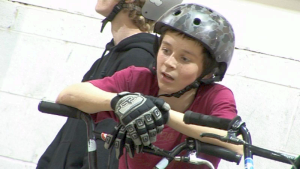

 And skateboarding sometimes forms part of the worship.
And skateboarding sometimes forms part of the worship.

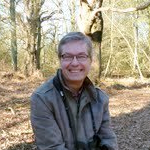
 Mennonites – Amish first cousins, plain dressing, peaceable types? Well, yes that's the conservative wing of the Tradition but – in practice – Mennonites come in all shapes and sizes. Our Wood Green Mennonite Church is a little left of centre. Not a buggy in sight!
Mennonites – Amish first cousins, plain dressing, peaceable types? Well, yes that's the conservative wing of the Tradition but – in practice – Mennonites come in all shapes and sizes. Our Wood Green Mennonite Church is a little left of centre. Not a buggy in sight!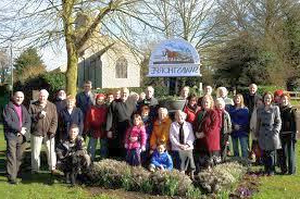
 Gradually the church has got more involved in running events for the whole village. In 2012, the old church building – which is the only public building in the village – is being reordered to make it suitable for wider community use. When the work is done there are hopes to re-launch a monthly all age service with a new team and a mission project with an environmental focus.
Gradually the church has got more involved in running events for the whole village. In 2012, the old church building – which is the only public building in the village – is being reordered to make it suitable for wider community use. When the work is done there are hopes to re-launch a monthly all age service with a new team and a mission project with an environmental focus.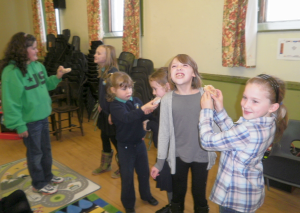
 I did msm South Wales in 2009-2010. It was timely for us to do it as Llantwit Major Benefice has nine churches, three clergy and three Readers! It gave us the kick start to do things, providing a reason to stop delaying and get on with it.
I did msm South Wales in 2009-2010. It was timely for us to do it as Llantwit Major Benefice has nine churches, three clergy and three Readers! It gave us the kick start to do things, providing a reason to stop delaying and get on with it. In a new atmosphere of optimism, I started the Messy Church at St James' Wick, which I ran for its first 18 months before handing it over.
In a new atmosphere of optimism, I started the Messy Church at St James' Wick, which I ran for its first 18 months before handing it over.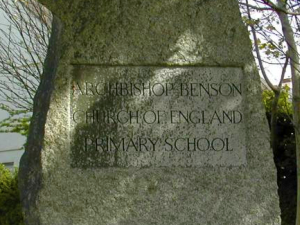
 Our journey has been one of great joy and constant surprises; all is not perfect but the joys far outweigh the few negatives. With a fresh expression of church I have been struck time and again – not just with the increasing numbers but by the fact that no-one attends because they feel they have to be there. Everybody attends because they want to be there. I certainly don't sense that we have got to the stage where parents are saying, 'Oh it's Wednesday, we'd better go to church.' Often it is the children who urge parents to keep on coming along simply because they enjoy it so much.
Our journey has been one of great joy and constant surprises; all is not perfect but the joys far outweigh the few negatives. With a fresh expression of church I have been struck time and again – not just with the increasing numbers but by the fact that no-one attends because they feel they have to be there. Everybody attends because they want to be there. I certainly don't sense that we have got to the stage where parents are saying, 'Oh it's Wednesday, we'd better go to church.' Often it is the children who urge parents to keep on coming along simply because they enjoy it so much. Given that any fresh expression of church will draw in and involve individuals who are new to, or simply exploring, the faith – perhaps for themselves and their children – it has been difficult in the early years to encourage people to lead activities, especially for children. We have rotas for refreshments and help with setting up but it is only recently that parents have been willing to come forward to prepare children's activities. The fact that this is now happening is an indication that some are 'growing' and becoming confident enough to step up and begin to engage in their own mission activity.
Given that any fresh expression of church will draw in and involve individuals who are new to, or simply exploring, the faith – perhaps for themselves and their children – it has been difficult in the early years to encourage people to lead activities, especially for children. We have rotas for refreshments and help with setting up but it is only recently that parents have been willing to come forward to prepare children's activities. The fact that this is now happening is an indication that some are 'growing' and becoming confident enough to step up and begin to engage in their own mission activity. My understanding of the Eucharist is that all are 'family' occasions and so the concept of a specific service labelled as 'family' is a misnomer to my mind. How then, could we address this age old problem in the parish church?
My understanding of the Eucharist is that all are 'family' occasions and so the concept of a specific service labelled as 'family' is a misnomer to my mind. How then, could we address this age old problem in the parish church? I have found that communication is a vital aspect of any fresh expression of church. I communicate primarily by email, text and via the Holy Commotion website with posts linked to a Facebook page and Twitter. It is demanding and time consuming – as is the preparation for both Holy Commotion (fortnightly) and Together in Worship.
I have found that communication is a vital aspect of any fresh expression of church. I communicate primarily by email, text and via the Holy Commotion website with posts linked to a Facebook page and Twitter. It is demanding and time consuming – as is the preparation for both Holy Commotion (fortnightly) and Together in Worship.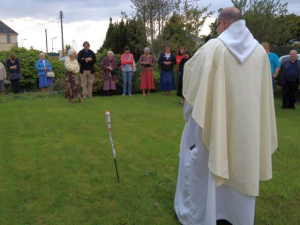
 Blessed in Gosport has been operating for 10 years now, initially growing out of work with an unchurched group of young people, drawing them into a sacred place.
Blessed in Gosport has been operating for 10 years now, initially growing out of work with an unchurched group of young people, drawing them into a sacred place. Eventually, the young people asked to do 'that thing' with the bread and wine. They didn't have the theology behind their request, just the language to express their yearning and Simon felt the need to respond to it. Blessed has always pursued an open table policy and with this sacramental outreach, began a process of conversion.
Eventually, the young people asked to do 'that thing' with the bread and wine. They didn't have the theology behind their request, just the language to express their yearning and Simon felt the need to respond to it. Blessed has always pursued an open table policy and with this sacramental outreach, began a process of conversion. After 10 years, Father Simon has answered a calling to go and establish another similar community in Plymouth. With the blessing of the team in Gosport, Simon moved house in April and has already started the process again with a group of older teenagers and young adults, giving them a new experience and interpretation of the sacrament.
After 10 years, Father Simon has answered a calling to go and establish another similar community in Plymouth. With the blessing of the team in Gosport, Simon moved house in April and has already started the process again with a group of older teenagers and young adults, giving them a new experience and interpretation of the sacrament.